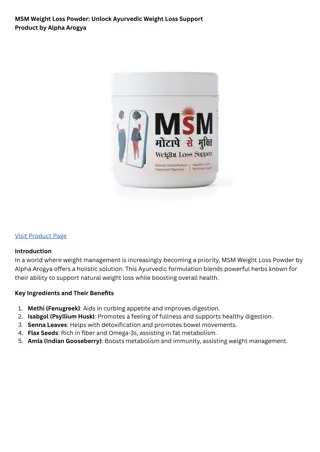
Social Influence and Memory Processes
Explore topics such as resistance to social influence, locus of control, social change, conformity, memory models, and forgetting. Learn how external factors affect behavior and memory.
Download Presentation

Please find below an Image/Link to download the presentation.
The content on the website is provided AS IS for your information and personal use only. It may not be sold, licensed, or shared on other websites without obtaining consent from the author. If you encounter any issues during the download, it is possible that the publisher has removed the file from their server.
You are allowed to download the files provided on this website for personal or commercial use, subject to the condition that they are used lawfully. All files are the property of their respective owners.
The content on the website is provided AS IS for your information and personal use only. It may not be sold, licensed, or shared on other websites without obtaining consent from the author.
E N D
Presentation Transcript
Exam question Resistance to social influence. 5. In a hospital, you are very likely to obey a nurse. However, if you meet her outside the hospital, for example in a shop, you are much less likely to obey. Using your knowledge of how people resist pressures to obey, explain why you are less likely to obey the nurse outside the hospital.
Exam Question: Locus of Control 6. Three students, George, Petra and Dan, have just started in the sixth form. Dan is a confident person who thinks that his fate lies firmly in his hands. By the end of the first week, Dan has put himself forward to be nominated as the class representative. Petra has also put her name forward to be nominated. She believes it is just luck whether or not she will be selected and feels that there is not much she can do about it. George did not put his name forward because his father told him not to. (a) (i) What type of locus of control does Petra s behaviour show? (ii) What type of locus of control does Dan s behaviour show?
Application Ada feels strongly about the safety of her children and has always sent them to school in flourescent clothing. At first, she was ridiculed, but she stuck to it, though she compromised as the chlidren now only wear the high-vis vests. Slowly, more and more parents started to do it and eventually a majority did so. It has become school policy. 10. Explain how social influence processes influence social change. (6m)
Conformity- Welcome to memory Lesson 1 To Outline the Multi-Store Model of Memory Key words: Multi-store Model Sensory register Short term memory Long term memory Coding Capacity Duration Compare sensory, short term and long term memory To Evaluate the evidence
Memory and Forgetting: Starter 1 What does your memory look like? 2 mins to draw a picture of what you think your memory looks like. Amina to judge!
What does memory look like to you? This is what memory looks like to me. https://www.youtube.com/watch?v=PQb2AvLqJ qM
Memory and Forgetting : Starter 2 What do you want to know about memory? What questions do you want answered? Write them on a post-it note to create a curiosity wall. See full size image
What would life be like if you had no short term memory?
What is memory? Is it remembering the places you have been?
What is memory? Is it remembering how to ride your bike?
What is memory? Is it recognising faces of people you know?
What is memory? Is it learning and recalling information?
What is memory? Is it recalling past events?
How accurate is memory? Can we rely on it?
Whats motivated forgetting? Freud
Can your physical state affect your recall If you learn stuff when happy, will you recall better when happy?
Do we recall items best where we learnt them?
What ways can you improve your memory? Try using colour...Can you think of any other ways?
From the media... http://www.youtube.com/watch?v=0vS0E9bBSL0 http://www.youtube.com/watch?v=O3GcvRe9G_w Can you think of others? Is it only fiction?
Atkinson and Shiffrin (1968) Atkinson and Shiffrin (1968) proposed multi- store model of memory which had two distinct stores: a short term store and a long term store In addition to these two stores, this model proposed that stimuli from the environment are held for a very brief time (less than one second) in a sensory register
What are the main features of the Multi Store Model of Memory
Multi-store model More info on the sensory store Sensory memory results from our perceptions. This is the first port of call for information. It gets its name from the fact that the information it receives is sensual (visual, auditory, smell, touch). By attending to certain aspects of an experience, sensory information can be brought together into an event in short term memory. The capacity is said to be vast but the duration is only 0.25 to 3 seconds. It includes various sub-systems: iconic memory of visual perceptions echoic memory of auditory perceptions.
Multi-store model: Capacity of Iconic Memory Sperling (1960) Aim: To investigate the capacity of iconic memory (visual sensory memory). Method: A three by four grid of numbers was flashed for 0.05 seconds. Followed by a high, medium or low pitched tone to indicate which row was to be recalled. Results: On average, the participants were able to recall 80% of the letters on the cued row. Conclusions: Since the participants didn't know which row was going to be called beforehand but still managed to recall it well, you can assume that at one time all of the information was held in the sensory memory. But it decayed very rapidly. Evaluation: The work by Sperling is the basis of the view that sensory memory stores are large but decay very rapidly. lasting 250 to 500 milliseconds.
Multi-store model Sperling (1960) Aim: To investigate the capacity of iconic memory (visual sensory memory). Method: A three by four grid of numbers was flashed for 0.05 seconds. Followed by a high, medium or low pitched tone to indicate which row was to be recalled.
Prepare yourself with a piece of paper and a pen. Do not write anything down until you are told. Look at the letters that will appear briefly on the screen. - If the letters are followed by full write down all the letters you can remember. - If the letters are followed by a high tone, write down all the letters you can remember from the top row. - If the letters are followed by a low tone, write down all the letters you can remember from the bottom row. Listen to a high and low tone now: High tone = Low tone =
Watch for the first letters. Click mouse to move on.
F A J Q M H G I N U Y Z
Watch for the letters. Click mouse to move on.
T D E L X C H O M B G S
Watch for the letters. Click mouse to move on.
D K P M V E S L A C W R
Watch for the letters. Click mouse to move on.
C R B P M H G I U S O L
Check your letters against the original matrices.
SHORT TERM MEMORY How good is your short term memory? What do you use it for? How long does it last? How much capacity does it have? What evidence is there?
George Armitage Miller's 'Magical Number Seven' (1956) Findings: The capacity of the short term memory is on average 7 2 items Methods: Various experiments involving asking participants to look at information and then recall it shortly after. Results: Participants would remember between 5 and 9 items on average, but this number would increase sometimes significantly if the participant used the 'chunking' technique of memorisation. Explanation: Why our brains are on average only capable of holding seven items is not a question that has been thoroughly answered (yet) - at the moment, we know that it simply is the case.
CAPACITY of STM George Miller (1956) The Magic Number Seven How much information can we hold in short term memory? How could you remember: BB-CA-BC-IT-VC-DR-OM-EM-AS-ONY BBC- ABC- ITV- CDROM- EMA- SONY Miller suggests it is between 5 and 9 items. (7 plus or minus 2) this is called CHUNKING.
Capacity experiment 2. Digit-span Technique (Jacobs, 1887) Complete the digit-span experiment. (separate PPT) How many numbers could you remember? Forwards? Backwards? Further evidence of the limited capacity of the STM.
Peterson and Peterson (1959) Findings: The average duration of information staying in the STM is 18 seconds Method: Participants were given trigrams - mixtures of 3 different letters e.g. AQP - and asked to recall them after varying amounts of time (0-18+ seconds). Results: Only 10% of participants could remember trigrams after 18 seconds Explanation: Without rehearsal, the STM can only hold information for around 18 seconds Extra With rehearsal, the duration of information that is held in the STM can be increased and according to the Peterson and Peterson model of memory it is through this rehearsal that information is transferred to the LTM from the STM This suggests that there is not LTM transfer unless there is rehearsal (this was proven to be incorrect by other models).
Duration of STM Peterson & Peterson (1959) Aim: To investigate the duration of short-term memory, and provide empirical evidence for the multi-store model. Procedure: A lab experiment was conducted. Participants had to recall trigrams (three letters, eg. TGH). To prevent rehersal participants were asked to count backwards in threes from a specified number. This is known as the brown peterson technique. Participants were asked to recall the trigram after intervals of either 3, 6, 9, 12, 15 or 18 seconds. Findings: The longer the interval delay the less trigrams were recalled. Participants were able to recall 80% of trigrams after a 3 seconds delay. However, after 18 seconds less than 5% of trigrams were recalled correctly. Conclusion: Short-term memory has a limited duration when rehearsal is prevented. It is thought that this information is lost from short-term memory from trace decay. The results of the study also show the short- term memory is different from long-term memory in terms of duration. Thus supporting the multi-store model of memory. Criticisms: This experiment has low ecological validity as people do not try to recall trigrams in real life.
Counting Peterson & Peterson (1959) Student Exercise backwards prevents rehearsal Instructions:- Read the consonants that appear below then count backwards in three s from the number given. Write down the letters you recall when asked. L Z M , P V Q, X F D 763 STOP! WRITE NOW! B F Y , G Z J, P D L 435 STOP! WRITE NOW! K M R , H G Y, J T Z 917 STOP! WRITE NOW! M Q L , T L Y, F R N 329 STOP! WRITE NOW! Peterson & Peterson showed that the duration of S.T.M. is between 18 30 secs.
Duration of STM Peterson & Peterson (1959) Limited 18 30 seconds.
What is a trigram What is at Trigram, and why use it? 1) The trigram has little or no meaning, unlike asking a person to remember a word which they may associate with something and be able to remember better. 2) There are no vowels in the trigram, preventing any easy pronunciation of the trigram as a word, which makes it more difficult to remember on any other basis than as a trigram. 3) Unlike words, the trigrams are equal in length, making the experiment less biased in terms of the information it requires participants to remember.











